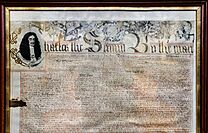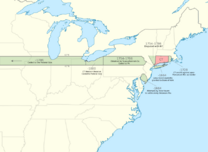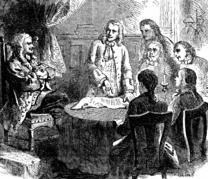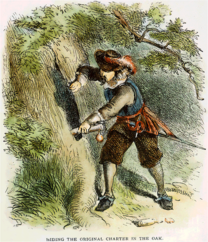History of the Connecticut Constitution facts for kids
Connecticut is often called "The Constitution State." This nickname likely comes from the Fundamental Orders of 1638–39. These orders were like a rulebook for the first government in Connecticut. They were also the first written plan for a government created by people's representatives in America.
Over time, Connecticut's government has used five different main documents to guide it. The early Connecticut Colony in Hartford followed the Fundamental Orders. The New Haven Colony had its own rules called The Fundamental Agreement of the New Haven Colony, signed in 1639.
In 1662, King Charles II of England gave Connecticut a special royal charter. This charter helped set up the state's government. However, it didn't have separate government branches like we see today. The General Assembly held most of the power back then. Connecticut didn't get a true constitution until 1818. The constitution used today was put in place in 1965. It kept most of the 1818 rules but added some important changes.
Contents
Connecticut's Early Government and Religion
The Fundamental Orders of Connecticut were adopted on January 14, 1639. Many people call this document the world's first written constitution. A powerful preacher named Thomas Hooker encouraged its creation. The Connecticut General Court, which was their lawmaking group, started working on it in June 1638. The Fundamental Orders soon became the main rules for Connecticut's government.
Connecticut was started by Puritans from the Massachusetts Bay Colony around 1635 and 1636. The first towns were Windsor, Wethersfield, and Hartford, Connecticut, along the Connecticut River. A key goal of the Fundamental Orders was to connect these towns officially. The rules were based on the religious beliefs of the colony's founders. They wanted "an orderly and decent government according to God." They also said the governor must always be a member of a church.
The New Haven Colony was separate at first. Their Fundamental Agreement (1639) said that only church members could vote. The Fundamental Orders also limited who could vote. To be a freeman (voter), a male had to be at least 21 years old. He also needed to own a certain amount of land or other valuable property.
How Connecticut's Government Changed (1639-1818)
Connecticut's government grew and changed a lot from 1638 to 1818. Reverend Thomas Hooker's ideas from 1638 helped shape it. The original Fundamental Orders of 1639 had some separation of powers. But one group, the General Court, was very strong. However, the colony could elect its own governor and choose its own judges. This was different from other colonies where the king appointed leaders. Over the next 50 years, the government became two-sided, with a stronger governor and more independent judges.
The General Court started as one powerful group that made all the laws. In 1698, it split into two parts and was renamed the General Assembly. Even then, it still had more power than the governor or the judges until 1818. After the split, the General Assembly had a Council and an Assembly. The Council was stronger. It included the governor, lieutenant governor, and 12 elected assistants. The Assembly had representatives from each town.
At first, the governor's job was mostly symbolic. The governor could not pardon people or stop bills passed by the General Assembly. Under the Fundamental Orders, a governor could only serve for two years and could not be re-elected right away. For many years, John Haynes and Edward Hopkins took turns being governor. The governor's main roles were as a public official and a member of the lawmaking group.
In 1667, King James II tried to take control of the colonies. He sent Sir Edmund Andros to be governor of the Dominion of New England. This led to the famous Charter Oak incident. After this, the governor's position became stronger. From 1689 to 1776, Connecticut had only nine governors. They stayed in office for about 10 years on average. Connecticut became known as "the land of steady habits" because people kept re-electing the same leaders. Wars also made the governor's role more important, especially during the American Revolutionary War. The governor was in charge of the state's army.
The judges had the least power under the Fundamental Orders. Until 1818, the lawmaking group (the legislature) was the highest court. If someone didn't like a court's decision, they could ask the legislature to review it. This sometimes caused problems. In 1784, the Supreme Court of Errors was created to handle appeals. It was made up of members of the Council. But this still led to conflicts of interest.
In 1806, the General Assembly changed the Supreme Court of Errors again. Nine Superior Court judges became the Supreme Court of Errors when they met together. This created a separate group of judges. However, the General Assembly could still overturn their decisions. Also, a judge might review a case he had already heard in a lower court.
A famous example of the legislature interfering with the courts happened in 1815. Peter Lung was found guilty of murder and sentenced to death. The General Assembly overturned his conviction. The court tried him again, found him guilty, and then executed him. This case made all Connecticut judges angry, especially Chief Justice Zephaniah Swift. He spoke out for judges to be independent. Creating an independent court system became a major reason for a new constitution.
The Connecticut Charter of 1662
In 1660, the English monarchy was restored, and King Charles II became king. Connecticut had never been officially recognized by the English government. So, the General Court decided Connecticut's independence needed to be made official. Governor John Winthrop Jr. traveled to England in July 1661 to talk with the English government. He was successful! The English attorney general approved a bill for the Connecticut Charter. The document was sent back to Connecticut and officially adopted on October 9, 1662.
The Connecticut Charter replaced the Fundamental Orders as the main governing document. However, it didn't change how the government worked very much. Connecticut continued to operate mostly as it had before. The Charter did make a few important changes. All colonists in Connecticut were given the same freedoms as people in England. The governor gained the power to call meetings of the General Court. Regular citizens lost this ability.
The Charter also set Connecticut's borders. It said the colony stretched from Narragansett Bay in the east to Massachusetts in the north. Its southwestern border was expanded all the way to the "South Sea on the West," which meant the Pacific Ocean! Connecticut's borders never actually reached that far. But the Charter did place the separate New Haven Colony under Connecticut's control. Some judges who had sentenced King Charles I to death had hidden in New Haven. King Charles II might have been getting revenge. After a short disagreement, New Haven decided to join Connecticut in 1665. Today, the city of New Haven still has Three Judges Cave on West Rock. It is a tribute to the judges who hid from King Charles II's agents.
The Charter Oak Incident
Two years after the Connecticut Charter was granted, King Charles II gave his brother, James, Duke of York, land for a New York Colony. This land stretched from the Delaware River to the Connecticut River. This created a conflict with Connecticut's Charter. Edmund Andros became the governor of New York in 1674. In 1675, Andros sailed to Connecticut. He demanded that all land west of the Connecticut River be given to James. Captain Bull of the Connecticut Militia refused to let him enter the colony. Andros returned to New York.
Ten years later, James became King James II after his brother Charles II died. King James II created a new colony called the Dominion of New England. It combined seven colonies from New Jersey to New Hampshire. Sir Edmund Andros was appointed its governor. In 1686, he demanded that all seven colonies give up their charters, saying they were no longer valid. Connecticut ignored him at first. Andros then sent a legal order to the governor, again demanding the charter. Finally, he went to Hartford with soldiers on October 31, 1687.
The exact details of what happened next are not fully known. But the common story is that Andros met with the colony's leaders one night. He expected them to hand over the charter, which was lying on a table. Suddenly, the candles were blown out, making the room dark. When the lights were lit again, the charter was gone! Joseph Wadsworth supposedly took the document and hid it in an oak tree on the Wyllys estate. This tree became known as the Charter Oak, a famous Connecticut landmark. We don't know for sure if this story is completely true. But it is certain that Andros never got his hands on the charter.
Despite this, Andros did briefly force Connecticut to accept his rule. The General Court of Connecticut even declared itself dissolved. But Andros's rule ended after The Glorious Revolution in England in November 1688. He was removed from power soon after.
Connecticut then had to decide how to restart its government. Some wanted direct ties to the king. Others wanted to write a completely new charter. But Connecticut decided to go back to how things were. The government under the Charter was put back in place. All the leaders who were there before Andros were reinstated. In May 1689, the General Court announced that all laws and courts would be in full effect again.
The colony then asked the king to approve their return to operating under the charter. Meanwhile, New York Governor Benjamin Fletcher tried to claim military power over Connecticut. John Winthrop's son, Fitz John, went to England as his father had done years before. He was successful. The king's legal advisors told him the charter was still valid. The king approved it on April 19, 1694. This marked the end of serious challenges to Connecticut's independence.
Connecticut After the Revolution
The General Assembly officially approved the Declaration of Independence. This was especially important since Connecticut's own Roger Sherman helped write it. The legislature stated that Connecticut's government would continue as set up by King Charles II's Charter. This would happen as long as it fit with the state's complete independence from Great Britain. Even after becoming independent, Connecticut wanted to keep using the King's Charter. Most of the other thirteen colonies had written their own state constitutions by 1786. But Connecticut chose to keep using the Charter. Connecticut continued with this government plan until 1818. That's when its first true constitution was adopted.
The Constitution of 1818
In 1816, the Federalist Party and the official Congregationalist Church controlled Connecticut. Connecticut was known as "the land of steady habits." This was because people kept re-electing leaders until they died. The Democratic-Republican party had started in 1804. But Connecticut was one of the last places where the Federalist party was still strong. After Massachusetts passed a religious freedom law in 1811, Connecticut was the last state to have an official state religion. It also had the only constitution still based on rules from the British Empire.
In 1815, different religious groups like Episcopalians, Baptists, and Methodists joined with the Democratic-Republican party. They formed the Toleration Party. In 1816, they held a meeting and chose candidates for election. In 1817, they won control of the state Assembly (the lower house). They also elected Oliver Wolcott Jr. as Governor and Jonathan Ingersoll as Lieutenant-governor.
Since 1639, a special "Anniversary Election Sermon" was given each year. It celebrated the connection between church and state. A parade of soldiers, lawmakers, and religious leaders would march through Hartford. Then, a well-known religious leader would give a political sermon to the Assembly. These sermons were very important. For example, President Ezra Stiles of Yale gave one in 1783 that lasted five hours! It was 99 pages long when printed.
Governor Wolcott knew the Toleration Party would soon have a small majority in the upper house after the 1818 spring elections. He asked Episcopalian Rev. Harry Croswell to give the important Anniversary Election Sermon that year. Croswell was a former journalist who had been sued for libel. He had left politics for religion and was now a rector in New Haven. But he didn't give a typical political sermon. Instead, in the spring of 1818, he strongly argued for a complete separation of church and state.
Croswell's sermon had a big and immediate impact. It was printed four times around the state, which was unheard of. Croswell's sermon was only 11 pages long when printed, about 30 minutes when spoken.
Right after this unusually short sermon, the General Assembly met. They made a big change to voting rights in Connecticut. All white males who paid taxes or served in the military could now vote. This removed the old property requirements. These rules had become difficult as more people worked in business or factories instead of farming.
Even more importantly, the General Assembly also called for a constitutional convention that year. The most important vote was whether a simple majority of the legislature would be enough to approve the new constitution. Many wanted a much higher majority, like 60% or 80%.
It seems Croswell's popular sermon helped. Those who wanted a simple majority won the vote by 81 to 80. So, by just one vote, the resolution passed. This was vital for the new constitution to succeed. It would separate the state church from the government.
Each town sent delegates to the convention. The number of delegates was equal to their representatives in the Assembly. The convention met in Hartford on August 26, 1818. One of the first things they did was appoint a committee to write a draft constitution. The very next day, the committee returned with the Preamble and Bill of Rights. They were fast because they copied it almost word-for-word from Mississippi's constitution from 1817.
After the rest of the constitution was written, the convention approved it by a two-to-one vote on September 16, 1818. Voters had three weeks to think about the proposed constitution. A vote was held on October 5. A small majority voted for the constitution, with 13,918 votes for and 12,364 against. The final vote showed how important it was to only need a simple majority. A 60% or 80% requirement would not have been met.
Because of the new constitution, the Congregational Church was finally no longer the official state church. However, Christianity remained the favored religion. New voting rights were also made official. All white males who paid taxes or served in the military could now vote. The 1818 Constitution finally brought separation of powers to Connecticut's government. The word "white" was also added as a voting requirement.
An independent court system was approved. Both Supreme and Superior Court judges now served for life until age seventy. (This was changed to eight years in 1856). The Supreme Court of Errors was reduced to five judges. Each judge also kept a role as a Superior Court judge. Decisions from the court could no longer be appealed to the legislature.
The constitution did not change the governor's role much. The governor remained relatively weak. However, the governor became a constitutional and independent part of the government. The governor was no longer allowed to sit in the legislature. He was given the new power to veto bills. But any of his vetoes could be overturned by a simple majority vote from the Assembly. This made the veto power almost useless. The General Assembly kept the power to nominate judges under the new constitution. This didn't change until 1880, when the governor gained the power to nominate judges.
The lawmaking branch also saw some changes. The Council was renamed the Senate. By constitutional rule, half of the legislative sessions had to be in Hartford. The other half met in New Haven. Surprisingly, the way towns were given representatives did not change. Each town that existed before the constitution kept two representatives in the lower house. This was true no matter how many people lived there. A few newer towns were given one vote.
Many changes were added over the years. But the Constitution of 1818 stayed in use until 1965. There was also a Constitution of 1955. But it mostly just put earlier changes into the main body of the constitution.
The Constitution of 1965
Connecticut uses the constitution passed in 1965 today. The main reason for the 1965 constitutional convention was to fix how representatives were assigned. Giving each town one or two representatives had led to unfair representation. Small towns had the same number of representatives as large cities. Besides this big change, most of the words from the 1818 Constitution were kept the same in 1965.
Non-Christians finally gained official freedom of religion in 1965. A law in 1843 had recognized Jews' right to worship. But these laws were often ignored after many Jewish and Catholic immigrants arrived in the late 1800s. The mention of Christianity from the older constitution was removed. After 1965, the Supreme Court of Errors' name was changed to the Connecticut Supreme Court.
The governor gained important power under the new constitution. The governor still cannot pardon people. But the office was given a stronger veto power. Now, to overturn a governor's veto, the legislature needs two-thirds support in both houses. Also, the 1965 Constitution includes a right to free public education. In addition, the newest constitution created a way to hold future constitutional conventions if needed.
The Constitution of 1965 is still the highest authority in Connecticut today. It is the fourth different document in the state's history that explains how its government works. Connecticut is known as the Constitution State because it adopted the Fundamental Orders early on in 1639. This is thought to be the earliest document of its kind in the western civilization. Since then, Connecticut has faced several big constitutional challenges and changes. These have led the state to how it is today.





